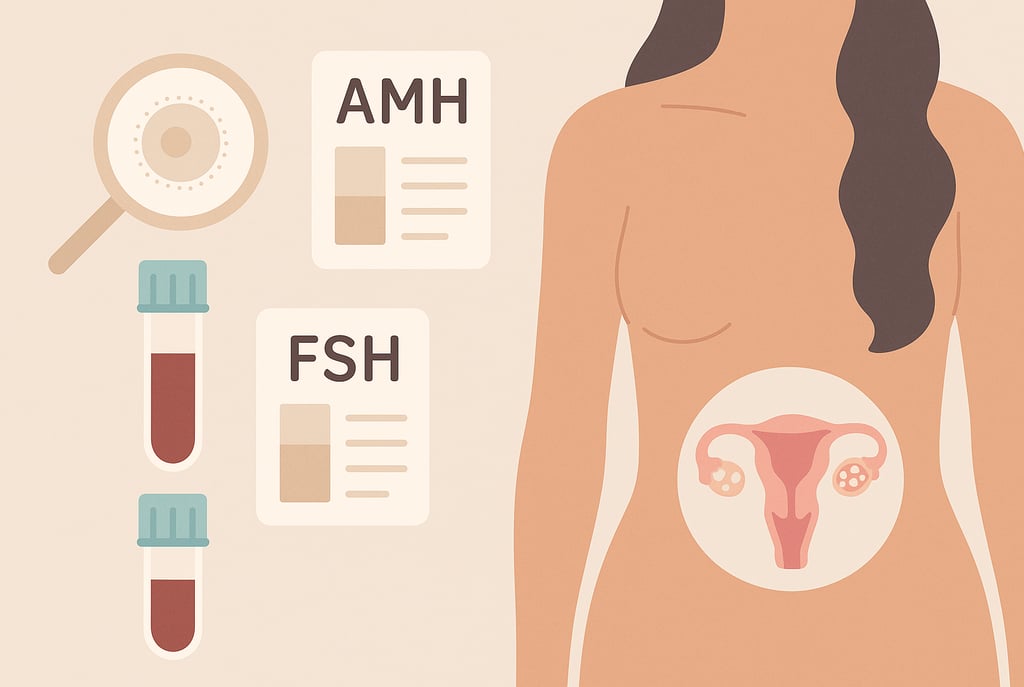AMH, FSH, and Egg Reserve Explained
Blog post description.
DIAGNOSIS & TESTING
6/26/20252 min read


When you're starting fertility testing, it's easy to feel overwhelmed by the jargon. AMH. FSH. Egg reserve. What do these terms mean, and why do they matter? This post will walk you through the essential hormone tests that help assess your ovarian reserve—and what the results might mean for your IVF journey.
What Is Ovarian Reserve?
Ovarian reserve refers to the number (and to some extent, the quality) of eggs remaining in your ovaries. Every person is born with all the eggs they will ever have, and this supply naturally declines with age. Assessing ovarian reserve can give your fertility clinic insight into how your body might respond to IVF medications and how likely it is that you'll retrieve a good number of mature eggs.
Two key hormones used to evaluate ovarian reserve are AMH (Anti-Müllerian Hormone) and FSH (Follicle-Stimulating Hormone).
What Is AMH?
AMH (Anti-Müllerian Hormone) is produced by the small follicles in your ovaries. These are the follicles that have the potential to grow and release eggs during your cycle. Because AMH levels reflect the number of these resting follicles, they offer a snapshot of your current egg reserve.
AMH Levels and What They Mean:
High AMH (e.g. >4.0 ng/mL): May suggest polycystic ovary syndrome (PCOS) or a high ovarian reserve. In IVF, this can be linked to a strong response to stimulation.
Normal AMH (around 1.0 - 4.0 ng/mL): Generally indicates a healthy ovarian reserve.
Low AMH (<1.0 ng/mL): May point to diminished ovarian reserve, common as you age, but also seen in younger people. It doesn't mean IVF won't work, but it may affect your protocol or expected egg yield.
AMH can be tested at any point in your cycle and doesn’t vary much month to month.
What Is FSH?
FSH (Follicle-Stimulating Hormone) is released by the brain and signals your ovaries to start maturing follicles. If your ovaries aren't responding well, your brain increases FSH to try to stimulate them harder.
FSH Levels and What They Mean:
Low to Normal FSH (e.g. 3-9 IU/L): Typically suggests your ovaries are responding normally.
High FSH (above 10 IU/L, especially if >15 IU/L): May indicate a reduced ovarian reserve. Your body is working harder to stimulate the ovaries.
FSH must be tested on day 2-4 of your menstrual cycle for an accurate reading.
AMH vs. FSH: Which Is Better?
Each test gives different information. AMH is more stable and useful for predicting your response to IVF medication. FSH can fluctuate, but very high FSH can be a red flag for ovarian decline. Many clinics use both to get a full picture.
Other tests that may be included in your ovarian reserve work-up:
Antral Follicle Count (AFC) via ultrasound
Estradiol (E2) levels
What These Tests Mean for IVF
Knowing your ovarian reserve helps personalise your treatment:
High AMH: You may need a lower dose of stimulation medication to avoid over-response.
Low AMH / High FSH: Your clinic may discuss more aggressive protocols, add-ons like DHEA or growth hormone, or even donor eggs if appropriate.
But numbers aren't everything. AMH and FSH can't tell you about egg quality, and people with low AMH still have healthy babies with IVF.
A Word of Caution
Low AMH doesn't mean you're infertile. These tests are tools—not verdicts. They help guide decisions, but many people with "low" results go on to conceive. Always interpret them alongside your full clinical picture
© 2025. All rights reserved.
